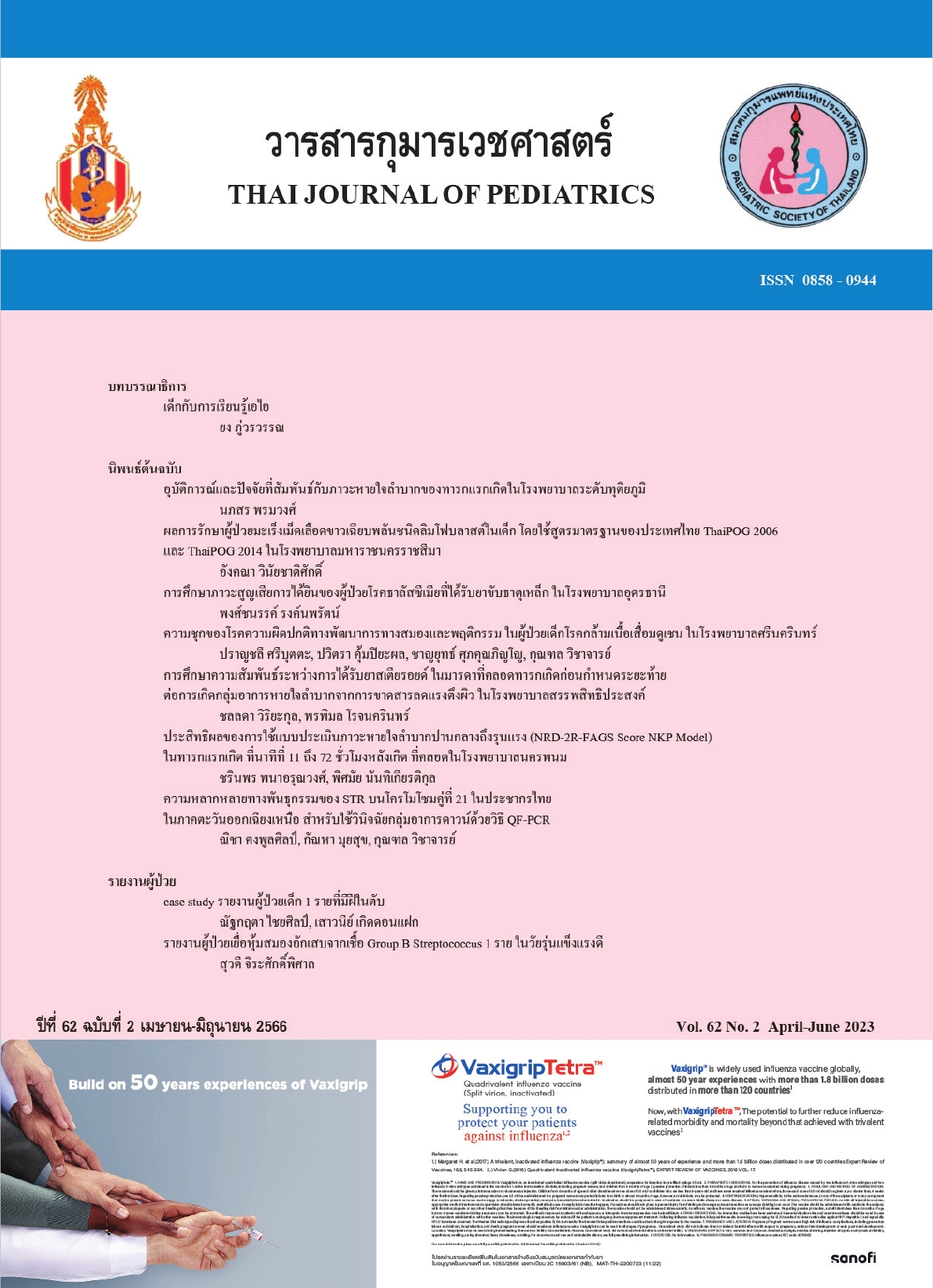ผลการรักษาผู้ป่วยมะเร็งเม็ดเลือดขาวเฉียบพลัน ชนิดลิมโฟบลาสต์ในเด็ก โดยใช้สูตรมาตรฐานของประเทศไทย ThaiPOG 2006 และ ThaiPOG 2014 ในโรงพยาบาลมหาราชนครราชสีมา
คำสำคัญ:
มะเร็งเม็ดเลือดขาวเฉียบพลันชนิดลิมโฟบลาสต์, ผลการรักษา, อัตราการรอดชีวิตบทคัดย่อ
มะเร็งเม็ดเลือดขาวเฉียบพลันชนิดลิมโฟบลาสต์ เป็นมะเร็งที่พบบ่อยที่สุดในผู้ป่วยเด็ก การรักษาในประเทศไทยใช้สูตรมาตรฐาน จัดทำโดยชมรมโรคมะเร็งเด็กแห่งประเทศไทยตั้งแต่ปี 2549
วัตถุประสงค์ : เพื่อศึกษาผลการรักษาผู้ป่วยมะเร็งเม็ดเลือดขาวชนิดลิมโฟบลาสต์ในโรงพยาบาลมหาราช นครราชสีมา โดยใช้สูตรมาตรฐาน 2 ช่วงเวลา
วิธีการศึกษา : ทำการศึกษาย้อนหลังในผู้ป่วยเด็กที่ได้รับการวินิจฉัยเป็นมะเร็งเม็ดเลือดขาวเฉียบพลัน ชนิดลิมโฟบลาสต์ และรักษาที่โรงพยาบาลมหาราชนครราชสีมา โดยแบ่งการรักษาเป็น 2 ช่วงช่วงแรก 1 มกราคม 2553 ถึง 31 สิงหาคม 2556รักษาโดยใช้ ThaiPOG 2006 ช่วงที่ 2 ตั้งแต่ 1 กันยายน 2556 ถึง 31 ธันวาคม 2561 รักษาโดยใช้ ThaiPOG 2014 รายงานอัตราการรอดชีวิตและอัตราการปลอดโรคโดยใช้ Kaplan Meier curves
ผลการศึกษา : มีผู้ป่วยในการศึกษานี้ทั้งหมด 265 ราย พบเพศชายมากกว่าเพศหญิง (1.5:1)ส่วนใหญ่มีอายุ 1-5 ปี (ร้อยละ 44.5) และเป็นชนิด pre-B cell (ร้อยละ 63.4) โดยช่วงแรกมีผู้ป่วยจำนวน 130 ราย ช่วงหลังมีผู้ป่วย 135 รายอัตราการรอดชีวิต 5 ปี ของผู้ป่วยทั้งหมด,ThaiPOG 2006, ThaiPOG 2014 เท่ากับร้อยละ 68.0, 66.4, 70.3 ตามลำดับอัตราการปลอดโรค 5 ปี ของผู้ป่วยทั้งหมด, ThaiPOG 2006, ThaiPOG 2014 เท่ากับร้อยละ 73.4, 68.2, 79.9 ตามลำดับมีอัตราการกลับเป็นซ้ำทั้งหมด, ThaiPOG 2006, ThaiPOG 2014 ร้อยละ 22.3, 29.2, 15.6 ตามลำดับ (p=0.008)
สรุป : ผลการรักษาในโรงพยาบาลมหาราชนครราชสีมาอยู่ในเกณฑ์ดี และสูตรยา ThaiPOG 2014 มี แนวโน้มทำให้อัตราการรอดชีวิตอัตราการปลอดโรคดีขึ้นและอัตราการกลับเป็นซ้ำลดลง
Downloads
เอกสารอ้างอิง
Wiangnon S, Veerakul G, Nuchprayoon I, et al. Childhood cancer incidence and survival 2003-2005, Thailand: Study from the Thai Pediatric Oncology Group. Asian Pacific J Cancer Prev 2011;12:2215-20.
Seksarn P, Wiangnon S, Veerakul G, Chotsampancharoen T, Kanjanapongkul S, Chainansamit S. Outcome of childhood acute lymphoblastic leukemia treated using the Thai National protocols. Asian Pac J Cancer Prev 2015;16:4609-14.
Micheal ET, Harland NS, Gregory HR, et al. Leu Lymphoma.2008; 49:1142-54.
Cool J. Improvements in the survival of children and adolescents with acute lymphoblastic leukemia. Haematologica. 2012;97:635.
Vora A, Goulden N, Mitchell C, et al. Augmented post-remission therapy for a minimal residual disease-defined high-risk subgroup of children and young people with clinical standard-risk and intermediate-risk acute lymphoblastic leukemia (UKALL 2003): a randomized controlled trial. Lancet Oncol 2014;15:809-18.
Larsen EC, Devidas M, Chen S, et al. Dexamethasone and high-dose methotrexate improve outcome for children and young adults with high-risk B-acute lymphoblastic leukemia:A report from Children’s Oncology Group study AALL0232. J Clin Oncol 2016;34:2380-8.
Eric WT, Kevin CW, Audrey B, David AS, Michel PC. Survival Among Children Diagnosed With Acute Lymphoblastic Leukemia in the United States, by Race and Age, 2001 to 2009:Findings From the CONCORD-2 Study. Cancer.2017;123(sup pl24):5178-89.
Wiangnon S. Veerakul G, Nuchprayoon I, et al. Childhood Cancer Incidence and Survival 2003-2005, Thailand: Study from the Thai Pediatric Oncology Group.Asian Pac J Cancer Prev. 2014;15:7989-93.
Wongmeerit P, Suwanrungruang K, Jetsrisuparb A, Komvilaisak P, Wiangnon S. Trends in Survival of Childhood Cancers in a University Hospital, Northeast Thailand, 1993-2012. Asian Pac J Cancer Prev. 2016;17: 3515-9.
BunUatisai W. Jia-Mahasap B and Chitapanarux I. Treatment Outcomes of Acute Lymphoblastic Leukemia in both Children and adults using the Thai Pediatric Oncology Group-based protocol at Chiang Mai University hospital. Journal of Thai Association of Radiation Oncology;2019;25: 12-28.
Howard SC, Pedrosa M, Lins M, et al. Establishment of a Pediatric Oncology Program and Outcomes of Childhood Acute Lymphoblastic Leukemia in a Resource-Poor Area. JAMA. 2004;26:2471-75.
Micheal ET, Harland NS, Gregory HR, et al. Leu Lymphoma.2008; 49:1142-54.
Cool J. Improvements in the survival of children and adolescents with acute lymphoblastic leukemia. Haematologica. 2012;97:635.
Suraponchai P, Pakakasama S, Sirachainan N, et al. Comparative outcomes of Thai children with acute lymphoblastic leukemia treated with two consecutive protocols: 11-year experience. Leuk Lymphoma. 2012;53:891-900.
Tharnprisan P, Khiewyoo J, Sripraya P, Wiangnon S. Relapse-free Rate with Childhood Acute Lymphoblastic Leukemia Treated under the Thai National Protocol. Asian Pacific Journal of Cancer Prevention. 2013;14:1127-30.
Kanjanaponkul S. Outcome of Acute Lymphoblastic Leukemia Teratment Using National Protocols at the Queen Siritkit National Institute of Child Health. J Med Assoc Thai. 2014;97(6):1.
Eric WT, Kevin CW, Audrey B, David AS, Michel PC. Survival Among Children Diagnosed With Acute Lymphoblastic Leukemia in the United States, by Race and Age, 2001 to 2009:Findings From the CONCORD-2 Study. Cancer.2017;123(sup pl24):5178-89.
Hussein H, Sidhom I, Naga SA, et al. Outcome and prognostic factors of acute lymphoblastic leukemia in children at the National Cancer Institute, Egypt. J Pediatr Hematol Oncol 2004;26:507-14.
Meirizkia A, Ayu DR, Indra RM, Sari DP. 3-year survival rate in acute lymphoblastic leukemia: comparison of ALL-2006 and ALL-2013 protocols. Paediatr Indones 2021;61:155-64.
Seraneeyanon L, Suwansigh S. Treatment outcome of acute lymphoblastic leukemia in children in Chiangrai Prachanukroh hospital. Thai Ped
ดาวน์โหลด
เผยแพร่แล้ว
รูปแบบการอ้างอิง
ฉบับ
ประเภทบทความ
สัญญาอนุญาต

อนุญาตภายใต้เงื่อนไข Creative Commons Attribution-NonCommercial-NoDerivatives 4.0 International License.



